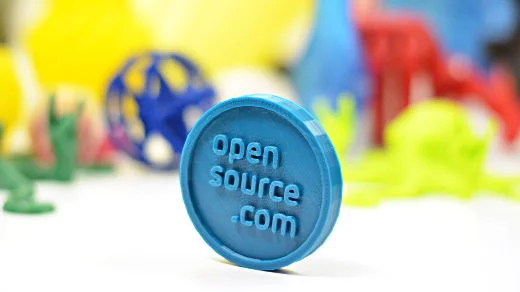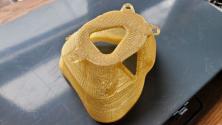Have you ever wondered who designs the colorful 3D printed demonstration objects commonly found in social media posts, online videos, hackerspaces, advertisements, websites, and trade show booths? If yes, then you have unknowingly recognized a major problem in the 3D printing community. Many of those objects are shared under Creative Commons licenses that require attribution be given to the designer, but there are no established standards on how or where credit should be given. And, there is generally no license information attached to the digital files that would make it easy to determine source.
The Creative Commons organization wants to change that.
The desktop 3D printing industry was born of a collaborative spirit, with individuals around the world working together to improve their RepRap DIY 3D printers. A tendency for 3D print designers to share their files under permissive licenses has persisted. There are now hundreds of thousands of freely-licensed 3D models available at no cost online, from decor and sculptures to functional tools and replacement parts. The challenge is that a large percentage of the models are shared under Creative Commons Attribution licenses, meaning that attribution to the creator of the model is required when sharing the file.
On June 29, I was fortunate to join a small group of 3D printing industry representatives, copyright and intellectual property attorneys, free information advocates, and government agency stakeholders at Singularity University Labs on the NASA Ames Campus in Mountain View, California. There, at a meeting hosted by the Creative Commons organization, we attempted to find solutions to the challenges surrounding attribution in 3D printing.
The questions posed were complex. Is attribution important to designers and why? What types of 3D model files are restricted by copyright and therefore can be licensed under Creative Commons? How can we make sure that license and source information follows files as they are copied, shared, and modified online? Do the 3D printed objects retain the copyright and licenses attached to the files that they were printed from? If so, what is the best way to present or display that information with the object? What technologies exist or can be developed to address these issues?
The meeting was aimed at putting priorities in focus and identifying methods that may address them. Below are some conclusions that seemed to be shared among the attendees. I should further clarify that I am not an attorney, and while several qualified attorneys participated in the meeting, nothing I have written should be misinterpreted as legal fact or advice.
- Attribution matters. Attribution is important to designers for numerous reasons varying from the personal gratification of seeing their name in print, to a desire to ensure that freely-licensed objects remain free. Proper attribution encourages content creators to continue sharing their work permissively, while lack of attribution can have the opposite effect.
- Copyright doesn't always apply. Creative Commons licenses are often misapplied to objects that are not subject to copyright restriction in the first place. For example, a Creative Commons license on a model of a purely functional shelf bracket is misapplied if the bracket was not restricted by copyright to begin with. However, if the bracket is creatively shaped like a tree branch, a Creative Commons license may be applicable. The line between creative and functional is fuzzy to put it mildly, but the distinction is important.
- The copyright of a digital 3D model persists through 3D printing. According to some of the attorneys in attendance, a 3D model file can be considered a "fixed representation of a 3D object" so 3D printing is not transformative enough to obfuscate any applicable copyright of the model file. It follows, that when a properly applied CC license calls for attribution, it is a legal requirement to provide it not only in re-shares of the model file, but also alongside or on the printed object itself, and in photos of the printed model.
- No one-size-fits-all solution for physical object attribution. Concepts like QR codes built into the models or embedded radio-frequency identification chips are largely impractical due to the wide variety of 3D printer resolutions, materials, and potential model geometries. Printed paper tags work fine for 3D prints displayed on tables, but what about jewelry or assemblies with moving parts? In the near term there is unlikely to be a standard, just an expectation that effort be made to provide attribution in some form with printed objects.
- New file types offer more features. License, attribution, and source information are not carried with the most popular 3D printing file type, STL. Several new file formats that contain XML metadata (among other features that STL lacks) are competing to replace STL across the industry. XML metadata, while not immutable, would be a great step toward solving the attribution and source issue as it pertains to the digital files themselves
- A long term solution. Finally, we discussed the implementation of an online "open ledger" for Creative Commons licensable works. It would provide a decentralized and immutable reference for attribution, license, and source of files while tracking changes and remixes. This is a complex project and will require buy-in from numerous stakeholders, but could provide an enduring tool to track attribution and give credit to the designers that share their work with the world via Creative Commons licensing.
Jane Park, Director of Platforms and Partnerships for Creative Commons, organized and chaired the meeting. She posted a more thorough write-up, The Challenge of Attribution, or "View Source," in 3D Printing, with next steps outlined along with a call for feedback from the community. At Aleph Objects, Inc., makers of LulzBot® 3D printers, we are excited to continue working with Creative Commons and similar organizations to advance efforts that respect user freedom and honor the intentions of content creators to freely share their work.







6 Comments